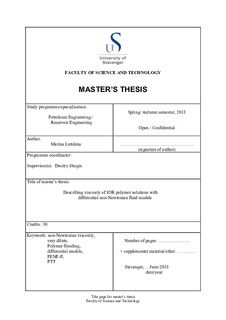Describing viscosity of IOR polymer solutions with differential non-Newtonian fluid models
Master thesis
Submitted version
Permanent lenke
http://hdl.handle.net/11250/2569362Utgivelsesdato
2018-06Metadata
Vis full innførselSamlinger
- Studentoppgaver (TN-IEP) [336]
Sammendrag
The non-Newtonian viscosity of multiple of polymers was measured.
For tests were taken polymers that are widely used in oil industry. They are:
HEC; Xanthan gum; Polypack; Flopaam: 5115VHM, 5115VLM, AN 125VHM, AN 125VLM, 3610VHM, 3130S.
These polymers were dilute to a number of low concentrations and viscosity for all of them was measured at rheometer with a cone-plate tool. All calculated and measured values are recorded in tables and presented in Experimental section [2].
The graphical analysis was performed for each polymer and trends were identified and compared between different polymers. The regions with “very dilute” concentrations were identified. This helped to find a criterion for “very dilute” solution. Such knowledge is very important due to gives a key to understanding what model can be applied for this particular polymer at this particular concentration.
Then data from measurements were tested against the prediction curves of several advanced, physic-based non-Newtonian models. These models are Finitely Extensible Nonlinear Elastic-Peterlin (FENE-P) dumbbell model, which was designed for dilute concentrations and exponential Phan-Thien-Tanner model (PTT), which was designed for concentrated solutions.
The ranges of concentrations with a good correlation between data points and model curves were identified for each polymer. Results from different polymers were compared and some similarity in trends identified.
The section Conclusions [4] sum up all conclusions that were made after experiments and analysis of model prediction.
Beskrivelse
Master's thesis in Petroleum Engineering
